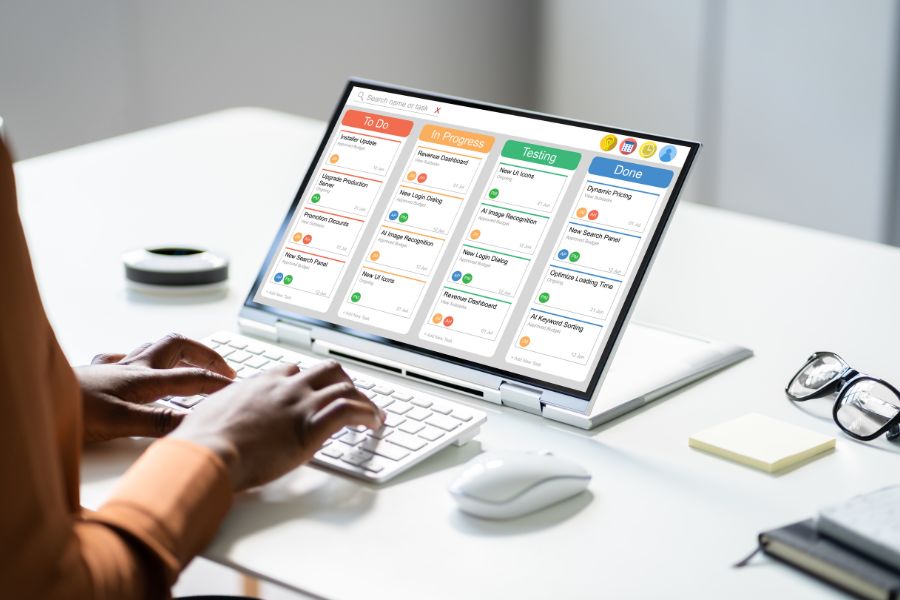Staying ahead of ever-changing customer demands is no small feat In the apparel manufacturing industry. Manufacturers must juggle the intricacies of fabric knitting, cutting, sewing, dyeing, printing, and finishing, all while ensuring that each step meets the highest quality standards. As the pressure intensifies to deliver products quickly and efficiently, the complexity of managing these processes grows, requiring close collaboration across teams and partners.
In this context, apparel inventory management software emerges as a powerful tool for manufacturers, helping streamline operations, minimize errors, and support decision-making to foster growth in an increasingly competitive market.
This article will explore the reasons why apparel inventory management software is key for growing brands, highlighting how it can improve efficiency, reduce waste, and enhance customer satisfaction, all while driving business growth.
Highlights:
- Apparel inventory management software centralizes stock tracking, order management, and real-time updates, streamlining operations across multiple sales channels.
- As brands expand, inventory management software helps maintain stock accuracy, meet customer demand, and scale operations efficiently while minimizing errors and waste.
What is apparel inventory management software?
Apparel inventory management software is a tool designed to help businesses track, organize, and control their stock of clothing and related products. It provides a centralized system to monitor quantities, manage reordering, and oversee distribution across various sales channels.
This type of software aids businesses in maintaining accurate records, reducing overstock or stockouts, and meeting customer demand promptly. Features often include barcode scanning, reporting tools, and integration with eCommerce platforms to synchronize inventory across physical stores and online outlets. It also supports forecasting and helps identify trends by analyzing sales data.
Why Apparel Inventory Management Software is Essential for Growing Brands
According to research published on Statista, global retail sales of apparel reached a staggering $1.53 trillion in 2022. This figure underscores the massive potential in the apparel industry, but it also highlights the risks involved. A report by Coresight Research and Celect found that $300 billion in revenue was lost due to markdowns in 2018 alone. This loss is a glaring reminder of how much money can slip through a company’s hands because of inventory mismanagement.
That’s why understanding the reasons behind optimizing fashion inventory management is key to long-term success.

Adapts to shifting trends
The apparel industry faces unpredictable customer demands driven by ever-changing trends. Forecasting demand for clothing, particularly in fast fashion, is one of the toughest challenges. Constant shifts in preferences make it risky to overstock inventory, as unsold items quickly become outdated. On the other hand, stocking too little can result in missed sales opportunities when sudden trends emerge.
For instance, social media often influences purchasing decisions, with platforms like TikTok creating sudden spikes in demand for specific outfits. In China, Zhao Lusi’s new outfits often sell out across e-commerce platforms, demonstrating how quickly trends can shift. Apparel inventory management software helps manufacturers and designers maintain a balance, responding effectively to these fluctuations while keeping waste and missed opportunities to a minimum.
Lowers holding costs
Excess inventory in apparel manufacturing leads to high expenses, especially with materials like silk, cashmere, or leopard fur, which have steep storage costs. When these fabrics remain unused in warehouses, they incur substantial fees, and there’s a risk that fashion trends will render them obsolete. Setting appropriate quantities of these raw materials is a key practice in managing inventory effectively, helping to avoid overstocking while maintaining sufficient supply.
Reorder points, integrated into apparel inventory systems, address these challenges by automating restocking decisions. When inventory drops below a pre-set threshold, orders are automatically triggered, maintaining stock levels within a safe range. This approach minimizes unnecessary purchases and avoids the accumulation of excess raw materials, ensuring a more controlled and cost-effective inventory process.
Provides data-driven insights
Apparel inventory management software allows manufacturers to maintain control over their inventory processes. It provides insights into customer purchasing habits, sales patterns, and the success of specific product lines.
Some manufacturers align with its rapid cycles in an industry where fast fashion dominates, while others prioritize sustainable practices. For those focusing on sustainability, managing inventory accurately becomes essential.
Missteps in production or stocking can result in unsold goods and dissatisfied customers. Monitoring inventory data supports informed decisions, helping manufacturers and designers effectively produce, market, and refine their product lines.
Optimizes production efficiency
Overproduction and underproduction are two significant challenges for apparel manufacturers. Even the best products lose value if produced in the wrong quantities. Balancing production becomes even more complex with the difficulty of accurately predicting consumer behavior, factoring in influencer trends, seasonal shifts, and unexpected market changes.
While apparel inventory software alone cannot guarantee perfect production outcomes, the data it provides plays a key role in decision-making. For instance, reports on product trends offer insights into the performance of specific items. These insights help manufacturers make more informed choices about continuing or discontinuing certain products, reduce risks, and align production with market demands.
Minimizes risks
Managing stock levels effectively in apparel inventory helps manufacturers avoid the costs associated with stockouts or overstocking. Excess inventory left at the end of a season often requires heavy discounts or results in financial losses due to unsold products.
On the other hand, insufficient inventory can lead to missed sales opportunities and harm customer relationships. If customers cannot find the needed products, they may turn to competitors, causing immediate and long-term revenue losses. Maintaining safety stock levels helps mitigate these risks, keeping operations steady.
Apparel inventory management software serves as a valuable tool for overseeing warehouse operations. With support for barcodes and RFID technology, it accelerates tasks while maintaining precision. The management of apparel inventory is particularly demanding due to the extensive range of colors, sizes, variations, and SKUs, but such tools simplify tracking and organization for manufacturers.
Prevents inventory losses
Inventory losses in the apparel industry can be a substantial drain on a business’s profitability, affecting both the bottom line and brand reputation. These losses stem from various factors such as overstocking, understocking, theft, damage, and poor forecasting. Each of these issues not only costs money but also ties up resources in ways that hinder operational efficiency.
Apparel inventory management software tackles these issues by providing real-time, accurate insights into stock levels across various locations, allowing businesses to respond quickly to shifting demands. Software can track the movement of goods from the supplier to the warehouse and from the warehouse to the customer, providing transparency in the entire supply chain. It enables businesses to set automated reorder points, ensuring that they never run out of popular items or overstock on slow-moving products.
More sophisticated apparel inventory systems can forecast demand more accurately using historical data and predictive analytics, reducing the risks of both overstocking and understocking. These tools track trends in consumer purchasing behavior, market seasonality, and external factors like social media buzz, ensuring that manufacturers stay ahead of the curve.
Improves product rotation
Effective inventory management plays a key role in improving product rotation in the apparel industry, which is crucial for maintaining fresh offerings and reducing the risk of obsolescence. Product rotation refers to the systematic approach of selling older stock first before newer stock, ensuring that inventory remains aligned with consumer demand and seasonal trends.
One way inventory management systems contribute to better product rotation is by tracking product age and sales velocity. By categorizing products by their entry date or time in stock, businesses can set up automatic alerts to prioritize older items. For example, when stock begins to age, the system can highlight these items, prompting businesses to push them to the front of the sales floor or feature them in promotional campaigns.
Such systems can also help identify slow-moving inventory, which may require strategic actions like discounts, promotions, or bundling with popular items. This ensures that products do not sit idly on shelves for too long, accumulating holding costs without generating revenue. With automation of this process, businesses can improve their ability to move inventory efficiently without relying solely on manual oversight.
Apparel inventory management software solution from ConnectPOS
ConnectPOS apparel inventory management software provides a robust solution designed to grow brand presence and streamline operations across multiple stores.
With omnichannel management, retailers can track inventory, handle transactions, and manage customer interactions in real-time, whether customers shop online, in-store, or across other touchpoints. This integration helps keep operations aligned across different sales channels.
- Robust inventory management is at the core of the ConnectPOS solution, providing real-time monitoring of product quantities, automated updates for sales and restocks, stock transfers, and stocktaking. The system also alerts users when inventory levels are low or overstocked, helping to maintain optimal stock levels and avoid costly inventory errors.
- The data-driven POS system collects and analyzes customer preferences, purchase history, and behaviors. This insight allows retailers to tailor their offerings, optimize business strategies, and deliver a more personalized shopping experience.
- Boost sales with exclusive features such as managing multiple variants and bundles, sorting items by brand, color, size, or material, and creating unique SKUs for bundles. This enables better inventory management and provides flexibility in product offerings.
- The personalization features let retailers track customer purchase history, wishlists, and shopping carts, recommending complementary items like accessories or shoes that match their style. This type of service deepens customer relationships with each interaction.
- Multiple payment methods, such as credit cards, mobile wallets, store credits, reward points, BOPIS (Buy Online, Pick Up In-Store), and split payments, give customers various ways to complete their transactions, improving convenience.
- Its loyalty program rewards every purchase with tailored recommendations, matching designs, and promotions. These incentives encourage customers to make full combo purchases, elevating the overall shopping experience.
- For in-store convenience, self-checkout options enable customers to quickly complete their purchases via barcode scans, bypassing queues and minimizing the need for assistance.
ConnectPOS apparel POS is an all-in-one solution that supports retailers in maintaining smooth, efficient operations while enhancing customer satisfaction and boosting sales.
FAQs: Apparel Inventory Management Software
- How does the software help with inventory accuracy?
Inventory management software reduces human error by automating tasks like stock tracking, order processing, and stock updates. Integration with barcode or RFID systems further improves inventory accuracy, ensuring real-time updates and minimizing discrepancies between physical and system stock levels.
- Can the software track inventory across multiple locations?
Yes, apparel inventory management software can track inventory across multiple stores, warehouses, or distribution centers. It ensures that inventory data is synchronized in real time, allowing businesses to manage stock transfers, order fulfillment, and customer orders efficiently across locations.
- How does the software assist with sales forecasting?
By analyzing past sales data and trends, the software helps businesses predict future demand. This allows retailers to make informed decisions about restocking, avoiding overproduction or underproduction, and optimizing stock levels for upcoming seasons or promotions.
Conclusion
To wrap up, apparel inventory management software is indispensable for brands looking to thrive in today’s fast-paced manufacturing environment. It provides a clear advantage by simplifying complex processes, reducing errors, and ensuring manufacturers can quickly adapt to fluctuating customer demands. As the apparel industry continues to evolve, brands that leverage effective inventory management will be better positioned to navigate challenges, stay competitive, and meet customer expectations
Ready to elevate your brand’s inventory management? ConnectPOS offers robust apparel inventory management solutions that streamline operations and support growth. Contact us today to learn how our platform can help you stay ahead of the competition and efficiently meet your customer demands.



